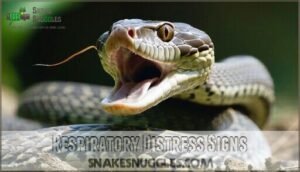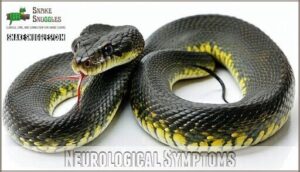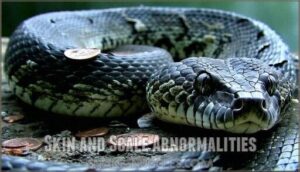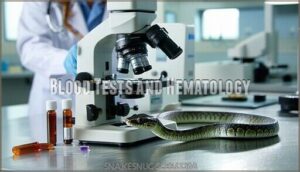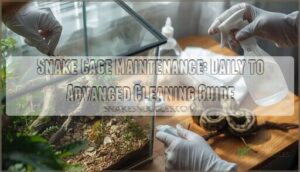This site is supported by our readers. We may earn a commission, at no cost to you, if you purchase through links.

Your best bet is supportive care that gives your snake’s immune system fighting power.
Crank up the temperature to 85-88°F (your snake’s version of chicken soup) and maintain 60-70% humidity.
Remove stressors, make certain proper quarantine, and work closely with an exotic vet for monitoring.
While you can’t zap the virus away, creating ideal conditions helps your scaly friend recover faster.
Some infections like IBD require different approaches than respiratory viruses, making proper diagnosis vital.
Table Of Contents
- Key Takeaways
- Common Viral Infections in Snakes
- Recognizing Symptoms of Snake Viral Infections
- Diagnostic Methods for Snake Viral Infections
- Frequently Asked Questions (FAQs)
- What should I do if my snake has a virus?
- How do you keep a snake from getting infected?
- How do you treat a snake respiratory infection?
- How can snake diseases be prevented?
- How do you treat snake parasites?
- How do you treat a snake septicemia?
- How to get rid of a snakes respiratory infection?
- How do you treat a snake with a nidovirus?
- What is the best antibiotic for snakes?
- What does an infection look like on a snake?
- Conclusion
Key Takeaways
- You can’t cure snake viruses directly – there’s no magic antiviral medication, so you’ll focus on supportive care that helps your snake’s immune system fight the infection naturally
- Create ideal recovery conditions – maintain temperatures at 85-88°F and humidity at 60-70% while removing all stressors from your snake’s environment to maximize healing potential
- Quarantine immediately and get professional help – isolate infected snakes to prevent spread and work closely with an exotic veterinarian for proper diagnosis and monitoring throughout recovery
- Early detection saves lives – watch for respiratory distress, neurological symptoms, weight loss, and behavioral changes, since catching viral infections early gives you the best chance of successful treatment
Common Viral Infections in Snakes
Snakes can contract several serious viral infections that require immediate attention and proper treatment strategies.
Viral threats lurk in every collection—early detection saves serpent lives.
You’ll encounter common viruses like Inclusion Body Disease in boas and pythons, respiratory-attacking Paramyxovirus, and the pneumonia-causing Nidovirus—each presenting unique challenges that demand specific care approaches.
Inclusion Body Disease (IBD)
Inclusion Body Disease (IBD) strikes right at the heart of boa and python collections, making it one of the most feared snake viral infections.
This reptarenavirus doesn’t mess around—IBD transmission often happens through direct contact or contaminated equipment, with boa susceptibility particularly high in captive populations. Python susceptibility leads to rapid, often fatal neurological decline, while boas may carry the virus for years before showing symptoms.
The disease, first discovered in the 1970s, now affects captive snake populations worldwide.
Here’s what makes IBD so challenging:
- IBD pathology creates characteristic inclusion bodies in blood cells
- Asymptomatic carriers silently spread infection throughout collections
- Snake virus diagnosis requires PCR testing and blood smear analysis
- Long-term IBD cases develop secondary infections and organ damage
- No snake virus treatment exists—euthanasia prevents suffering and spread
Early snake virus diagnosis through routine screening gives you the best chance of protecting your collection.
Adenovirus Infections
Unlike IBD’s narrow focus on boas and pythons, adenovirus infections sweep across multiple reptile species.
You’ll spot lethargy, weight loss, and diarrhea in affected snakes.
These hardy viruses spread through fecal-oral transmission routes, making proper hygiene your best defense.
Reptiles can contract the virus through fecal-oral transmission, even from asymptomatic carriers.
| Aspect | Details | Impact |
|---|---|---|
| Affected Species | Snakes, lizards, crocodilians | Wide host range increases outbreak risk |
| Primary Symptoms | Anorexia, wasting, lethargy | Often mistaken for other conditions |
| Transmission | Fecal-oral route | Highly contagious in collections |
| Diagnosis | PCR testing, liver inclusion bodies | Quick identification saves lives |
Adenovirus strains particularly target young snakes, with prevention strategies focusing on quarantine protocols and strict sanitation.
Herpesvirus Infections
Though herpesvirus infections in snakes are less common than in turtles, they can still cause serious health problems.
These sneaky viral diseases primarily affect your snake’s liver and digestive system, especially in younger boa constrictors. Don’t worry—early detection makes all the difference in managing these reptile viral diseases.
- Oral lesions and stomatitis develop as visible mouth sores requiring immediate attention
- Hepatic necrosis damages liver tissue, leading to digestive problems and weakness
- Weight loss and anorexia signal your snake’s struggling immune system needs support
- Respiratory symptoms like nasal discharge indicate the virus is spreading systemically
- Sudden death can occur in acute cases, making prevention absolutely critical
PCR testing provides accurate herpes diagnosis from tissue samples or swabs, helping you catch infections before they become life-threatening. Quarantine protocols are essential to prevent disease spread.
Paramyxovirus (Ferlavirus) Infections
Among viral infections snakes face, paramyxovirus (Ferlavirus) stands as a serious respiratory threat.
You’ll notice open-mouth breathing, wheezing, and nasal discharge as key warning signs. These Ferlavirus strains spread through transmission routes like respiratory secretions and direct contact.
Diagnostic challenges arise because symptoms mimic other conditions, making PCR testing essential. Long-term effects can devastate your collection if left unchecked.
| Symptom Category | Early Signs | Advanced Signs |
|---|---|---|
| Respiratory | Mild wheezing | Open-mouth breathing |
| Neurological | Head tremors | Complete paralysis |
| Physical | Slight lethargy | Severe weight loss |
| Behavioral | Reduced appetite | Total food refusal |
| General | Minor discharge | Sudden death |
Nidovirus (Coronavirus) Infections
Nidovirus infections pack a serious punch, targeting your python’s or boa’s respiratory system with pneumonia and mouth rot.
These coronavirus relatives spread like wildfire through collections, making nidovirus diagnosis through PCR testing your best defense.
Here’s your action plan for nidovirus prevention and care:
- Quarantine newcomers for 30+ days minimum – viral shedding can hide for weeks
- Watch for respiratory symptoms like open-mouth breathing, wheezing, and thick nasal discharge
- Get PCR testing immediately if you spot nidovirus symptoms – early detection saves lives
- Maintain strict biosecurity with separate tools, clothing changes, and thorough disinfection protocols
Nidovirus treatment currently focuses on supportive care since no specific antivirals exist. Your snake veterinary care team will likely prescribe antibiotics for secondary infections while nidovirus research continues advancing toward targeted therapies.
Retrovirus Infections
While other snake viral infections get the spotlight, retrovirus research reveals these sneaky pathogens can slip under your radar for months.
Retrovirus transmission occurs through direct contact and contaminated equipment, making retrovirus prevention challenging.
Unlike flashy symptoms from other viral diseases in snakes, retrovirus diagnostics require specialized testing since infected snakes often appear healthy.
Current retrovirus treatment remains limited, focusing on supportive care and preventing secondary infections through proper snake virus research protocols.
Recognizing Symptoms of Snake Viral Infections
Spotting viral infection symptoms in your snake early can mean the difference between successful treatment and serious complications.
You’ll want to watch for telltale signs like respiratory distress, unusual behavior changes, and physical abnormalities that signal your scaled friend needs immediate veterinary attention.
This includes being aware of respiratory distress, which is a critical indicator that your snake requires urgent care.
Respiratory Distress Signs
When something’s wrong with your snake’s breathing, you’ll notice it immediately.
Unlike their usual silent respiration, viral infections trigger obvious respiratory distress that demands attention:
- Wheezing sounds – audible breathing that sounds like a tiny whistle
- Open-mouth breathing – gaping instead of normal closed-mouth respiration
- Nasal discharge – clear or colored fluid from nostrils
- Head elevation – keeping their head raised while struggling to breathe
Watch for cyanosis signs too – bluish coloring around the mouth indicates serious oxygen deprivation requiring immediate veterinary care.
Neurological Symptoms
While respiratory issues grab your attention first, snake viral infections often attack the nervous system with devastating results.
Watch for these alarming neurological symptoms that demand immediate veterinary care:
- Tremor Analysis reveals "star-gazing" behavior – your snake’s head tilts skyward uncontrollably
- Seizure Management becomes critical when sudden convulsions strike without warning
- Paralysis Causes complete loss of movement in affected body segments
IBD Progression frequently triggers these nerve damage signs in boas and pythons.
You’ll notice disorientation, difficulty shedding, or abnormal posturing.
These snake viral symptoms indicate serious underlying issues requiring professional snake virus treatment and neurological assessment for proper snake viral diagnosis.
Gastrointestinal Issues
Watching your snake’s eating habits can reveal early warning signs of snake viral infections.
Appetite loss often strikes first—your normally ravenous reptile suddenly turns picky or stops eating entirely.
Snake vomiting and diarrhea causes messy cleanup while signaling serious gastrointestinal issues.
Conversely, constipation relief becomes necessary when your snake’s digestive system slows to a crawl.
Proper temperatures are essential for healthy digestion.
These gut microbiome disruptions aren’t just uncomfortable—they’re red flags demanding immediate attention for proper snake infection treatment.
Skin and Scale Abnormalities
Your snake’s skin tells a story—sometimes it’s not a happy one.
Abnormal shedding, scale discoloration, and ulcerations can signal viral infections lurking beneath the surface.
You’ll spot these skin abnormalities as clear warning signs that something’s wrong.
- Patches of dull, darkened scales that look like old pennies
- Incomplete shed pieces clinging stubbornly like unwanted bandages
- Blisters or growths appearing as mysterious bumps on otherwise smooth skin
Behavioral Changes
When your snake’s personality takes a sudden turn, it’s often screaming "something’s wrong!"
Behavioral changes like increased hiding behavior or unexpected aggression increase signal possible snake viral infections.
You’ll spot activity reduction – your once-curious serpent now lounging like a couch potato.
Social changes become obvious too; friendly snakes may become antisocial grumps, while normally feisty ones turn surprisingly mellow during snake disease symptoms.
Weight Loss and Anorexia
Appetite issues often signal the start of serious snake viral infections. When your snake turns away from food, it’s time to dig deeper into potential causes.
Key signs to monitor:
- Consistent food refusal – Missing 2+ feeding cycles indicates possible infection
- Visible weight loss – Check for protruding spine or loose skin around the body
- Lethargy during feeding – Snake shows no interest when prey is presented
- Digestive complications – Vomiting or regurgitation after successful feeding attempts
Early diagnostics and proper treatment with antiviral medications can help manage these symptoms effectively.
Diagnostic Methods for Snake Viral Infections
When you suspect your snake has a viral infection, accurate diagnosis becomes your top priority for effective treatment.
Modern veterinary techniques can pinpoint specific viruses quickly, helping you make informed decisions about your pet’s care and recovery plan.
Physical Examination Techniques
Three essential techniques help diagnose snake viral infections through thorough physical examination.
Start with these systematic checks:
- Body Condition – Assess weight loss, muscle tone, and overall appearance
- Skin Assessment – Check for shedding problems, lesions, or discoloration
- Respiration Check – Monitor breathing patterns for wheezing or mouth-breathing
- Oral Health – Examine mouth and cloacal areas for abnormal discharge or inflammation
A thorough exam may require a reptile veterinary stethoscope.
Blood Tests and Hematology
Blood tests reveal key infection markers that help your vet diagnose snake viral infections.
Elevated white blood cells often signal your snake’s immune system is fighting something.
In early stages of IBD, blood work shows characteristic inclusion bodies – tiny viral factories inside cells.
These tests give your vet a clear picture of your snake’s overall health status.
Vets also use blood work to identify if poor husbandry is a factor in order to provide a comprehensive diagnosis and treatment plan, focusing on the immune system and overall health status.
Polymerase Chain Reaction (PCR) Testing
PCR testing serves as your diagnostic ace in the hole for snake viral infections, delivering precise results that can make or break treatment decisions.
This molecular technique detects specific viral genetic material with exceptional PCR Accuracy, often exceeding 95% sensitivity when identifying pathogens like inclusion body disease.
Here’s what makes PCR testing invaluable for reptile virus diagnostics:
- Swift PCR Turnaround – Results arrive within 24-48 hours, letting you act fast
- Flexible Swab Samples – Oral, cloacal, or tracheal swabs work perfectly for live snakes
- Early Detection – Catches infections before symptoms appear, vital for Monitoring Carriers
- Virus-Specific – Differentiates between closely related pathogens with pinpoint precision
Despite PCR Limitations like potential false negatives during low viral shedding periods, this technology remains essential for reptile virus research and treatment planning.
You can even find resources for snake virus products online.
Frequently Asked Questions (FAQs)
What should I do if my snake has a virus?
Like a patient waiting for medicine, you’ll need professional veterinary care since there’s no cure for snake viruses.
Isolate your snake immediately, maintain ideal temperature and humidity, and provide supportive care while consulting a reptile veterinarian promptly.
How do you keep a snake from getting infected?
Quarantine new snakes for 4-6 months, maintain proper temperature and humidity, disinfect enclosures with bleach solution regularly, use separate tools for each snake, and schedule annual veterinary checkups.
How do you treat a snake respiratory infection?
Carefully combine careful veterinary consultation with antibiotics like enrofloxacin.
You’ll need supportive steam treatments using Vicks VapoRub and eucalyptus oil in boiling water.
Maintain proper temperatures and humidity while monitoring symptoms closely.
How can snake diseases be prevented?
Prevent snake diseases by quarantining new arrivals for 4-6 months, maintaining proper temperature and humidity, disinfecting enclosures regularly with bleach solution, and scheduling annual veterinary check-ups for early detection.
How do you treat snake parasites?
Fighting parasite problems is like battling invisible enemies—you’ll need the right weapons.
Deworming medications are injected or administered orally, with specific drugs determined by parasite type.
Always consult your reptile vet for proper diagnosis and treatment.
How do you treat a snake septicemia?
Rush your snake to a vet immediately—septicemia is a true emergency that requires aggressive treatment.
They’ll administer systemic antibiotics, fluid therapy, and provide an especially warm basking site for recovery.
How to get rid of a snakes respiratory infection?
Visit a reptile veterinarian immediately for proper diagnosis and antibiotic prescription.
Maintain ideal temperature and humidity in the enclosure.
Steam treatments using Vicks and eucalyptus can provide symptom relief while awaiting professional care.
How do you treat a snake with a nidovirus?
Unfortunately, there’s no cure for nidovirus infections in snakes.
You’ll need to provide supportive care with antibiotics for secondary infections, maintain proper temperature and humidity, guarantee hydration.
Work closely with a reptile veterinarian for symptom management.
What is the best antibiotic for snakes?
Enrofloxacin stands out as the top antibiotic choice for snake respiratory infections. Your vet should prescribe it based on culture results, though treatment often starts immediately given disease severity.
What does an infection look like on a snake?
You’ll spot infections through respiratory signs like wheezing, open-mouth breathing, and nasal discharge.
Look for neurological symptoms including tremors, seizures, or paralysis.
Check for skin discoloration, shedding problems, lethargy, and weight loss.
Conclusion
Remember, an ounce of prevention is worth a pound of cure—but when viral infections strike, you’ve got the tools to help your snake bounce back.
Learning how to treat snake viral infections successfully means combining proper environmental conditions, vigilant monitoring, and veterinary expertise.
You can’t cure viruses directly, but supportive care creates the perfect healing environment.
Keep temperatures ideal, maintain quarantine protocols, and watch for symptom changes.
With patience and consistent care, you’ll give your scaly companion the best shot at recovery and a healthy future ahead.
- https://coloradoexoticanimalhospital.com/reptiles-amphibians/serpentovirus-nidovirus-snakes
- https://vcahospitals.com/know-your-pet/snakes-diseases
- https://www.stengleinlab.org/blog/2017/12/19/Nidovirus_FAQ.html
- https://azeah.com/reptiles-amphibians/serpentovirus-nidovirus-snakes
- https://www.veterinary-practice.com/article/an-introduction-to-common-reptile-viral-diseases

